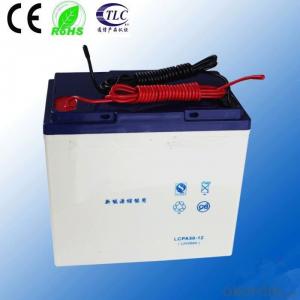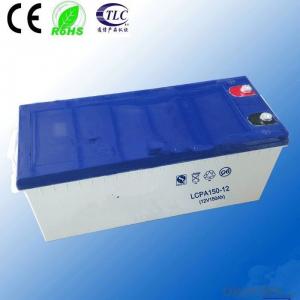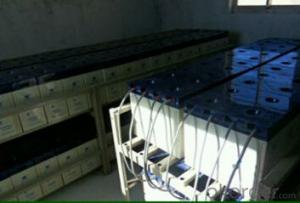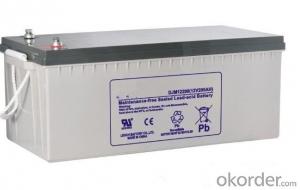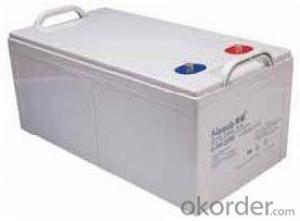sealed 12v 50ah deep cycle battery for home power system
- Loading Port:
- Shanghai
- Payment Terms:
- TT OR LC
- Min Order Qty:
- 10 unit
- Supply Capability:
- 5000 unit/month
OKorder Service Pledge
OKorder Financial Service
You Might Also Like
Quick Details
Place of Origin: Jiangsu, China (Mainland)
Brand Name: oliter deep cycle battery
Model Number: LCPC50-12
Usage: UPS
Voltage: 12v
Sealed Type: Sealed
Maintenance Type: Free
Size: 227*138*228(mm)
Weight: 15±0.5KG
Nominal Capacity: 50AH
Model: 12V50AH
size: 227*138*228(mm)
Nominal Capacity: 50AH
self-discharge: <2%/month
packing: cartoon
use: deep cycle battery
Specifications
12v 50ah deep cycle battery
1)manufacture with good quality
2)MSDS,ROHS,ISO9001,ISO14001
3)export experience 15 years
Product Description
Item | 12V 50AH deep cycle battery |
Brand Name | Oliter |
Model NO. | LCPC50-12 |
Battery type | storage battery |
Battery dimension | 227*138*228(mm) (L*W*H) |
Nominal voltage | 12v |
Nominal capacity | 50ah |
Net Weight | 15kg |
Cycle life | 100%DOD 572times , 50%DOD 1485 times , 30%DOD 2406times |
Battery Case | ABS |
Plate | lead-antimony |
Payment terms | T/T(with 30% deposit),70% paid by the copy of BL |
Loading port | Shanghai |
Main Market | America,Africa, Mid-east,Asia ,South America, Europe |
- Q: How to repair the battery?
- To the battery in accordance with the 0.1C current discharge, record the discharge time. Its discharge current multiplied by the number of hours of time, is the battery repair capacity. If the Chongqing battery capacity to reach the nominal capacity of more than 70%, the end of the repair.
- Q: What is the difference between a maintenance-free battery and a conventional battery?
- Lead-acid battery is composed of positive and negative plates, partitions, shell, electrolyte and wiring pile head and other components, the discharge of the chemical reaction is to rely on positive electrode active substances (lead dioxide and lead) and negative plate active substances (sponge Pure lead) in the electrolyte (dilute sulfuric acid solution) under the action, which plate grid, the traditional battery lead and antimony alloy manufacturing, maintenance-free battery is made of lead calcium alloy, the former with antimony, the latter with calcium, This is the fundamental difference between the two points.
- Q: How to determine the battery is good or bad?
- Observe the battery electrolyte is turbid, turbidity that the battery positive plate softening. Observe the bottom of the battery whether there is sediment, if the plate off the battery capacity has been inadequate. Hand hit the battery two electrode piles If you hear an empty voice that pole pile and plate break. With a thick wire short-circuit positive and negative pile observation of the battery filling holes, such as the discovery of a bubble appears that the interval has been damaged.
- Q: How to deal with waste batteries?
- In addition to lead-acid batteries, all kinds of batteries are dissolved in sulfuric acid, and then by means of ion resin from the solution to extract a variety of metals, raw materials obtained in this way than the heat treatment method is pure, so the market price is higher, and the battery contains 95% of the various substances can be extracted.
- Q: What battery does the van use?
- The battery is mainly composed of tube positive plate, negative plate, electrolyte, separator, battery compartment, battery cover, pole, injection liquid cover and so on. The electrode of the exhaust type battery is made of lead and lead oxide, and the electrolyte is an aqueous solution of sulfuric acid. The main advantage is the voltage stability, the price is cheap; the disadvantage is lower than the energy (that is, per kilogram of battery storage power), short life and routine maintenance frequently. Old ordinary battery life of about 2 years, and the need to regularly check the height of the electrolyte and add distilled water. However, with the development of science and technology, lead-acid battery life becomes longer and maintenance is also more simple.
- Q: What are the advantages of maintenance-free batteries?
- Maintenance-free battery using lead-calcium alloy grille, the amount of water generated when charging less water evaporation is low, with the shell with a sealed structure, the release of sulfuric acid gas is also very little, so with the above advantages.
- Q: 80ah how much battery storage capacity?
- Is 80AH. Understood to discharge at 80 amps for about 1 hour (but not to say that after 1 hour is finished, there is still electricity). In theory, this is your battery power.
- Q: What kind of battery is divided into?
- At present, we used the car battery is divided into three categories, namely, ordinary batteries, dry batteries and maintenance-free batteries three.
- Q: How does battery activation work?
- Always keep the battery surface clean. Found that the surface of dust and acid, it should be timely wipe, wipe can be wiped with soda water wipes wipe again, after rinse with water.
- Q: Lead-acid battery how to maintain?
- Open the rubber cap, exposing the exhaust raft, you can see the battery inside, some of the battery exhaust cutting can be unscrewed.
Send your message to us
sealed 12v 50ah deep cycle battery for home power system
- Loading Port:
- Shanghai
- Payment Terms:
- TT OR LC
- Min Order Qty:
- 10 unit
- Supply Capability:
- 5000 unit/month
OKorder Service Pledge
OKorder Financial Service
Similar products
Hot products
Hot Searches
Related keywords
